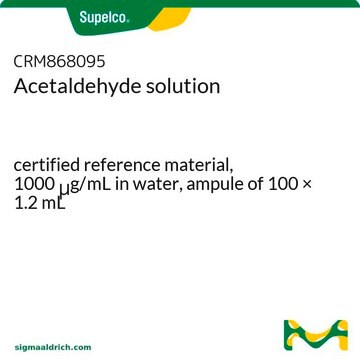W200387
Acetaldehyde solution
40 wt. % in isopropanol
About This Item
Produits recommandés
Source biologique
synthetic
Niveau de qualité
Conformité réglementaire
FDA 21 CFR 117
FDA 21 CFR 182.60
Forme
liquid
Concentration
35.00-45.00% (titration by hydroxylamine)
40 wt. % in isopropanol
Pf
-123 °C
Densité
0.868 g/mL at 20 °C
Application(s)
flavors and fragrances
Documentation
see Safety & Documentation for available documents
Allergène alimentaire
no known allergens
Propriétés organoleptiques
pungent; ethereal; fruity
Température de stockage
2-8°C
Chaîne SMILES
[H]C(C)=O
InChI
1S/C2H4O/c1-2-3/h2H,1H3
Clé InChI
IKHGUXGNUITLKF-UHFFFAOYSA-N
Vous recherchez des produits similaires ? Visite Guide de comparaison des produits
Clause de non-responsabilité
Mention d'avertissement
Danger
Mentions de danger
Conseils de prudence
Classification des risques
Carc. 1B - Eye Irrit. 2 - Flam. Liq. 1 - Muta. 2 - STOT SE 3
Organes cibles
Central nervous system, Respiratory system
Code de la classe de stockage
3 - Flammable liquids
Classe de danger pour l'eau (WGK)
WGK 3
Point d'éclair (°F)
-34.6 °F
Point d'éclair (°C)
-37 °C
Équipement de protection individuelle
Eyeshields, Faceshields, Gloves
Faites votre choix parmi les versions les plus récentes :
Déjà en possession de ce produit ?
Retrouvez la documentation relative aux produits que vous avez récemment achetés dans la Bibliothèque de documents.
Les clients ont également consulté
Notre équipe de scientifiques dispose d'une expérience dans tous les secteurs de la recherche, notamment en sciences de la vie, science des matériaux, synthèse chimique, chromatographie, analyse et dans de nombreux autres domaines..
Contacter notre Service technique






